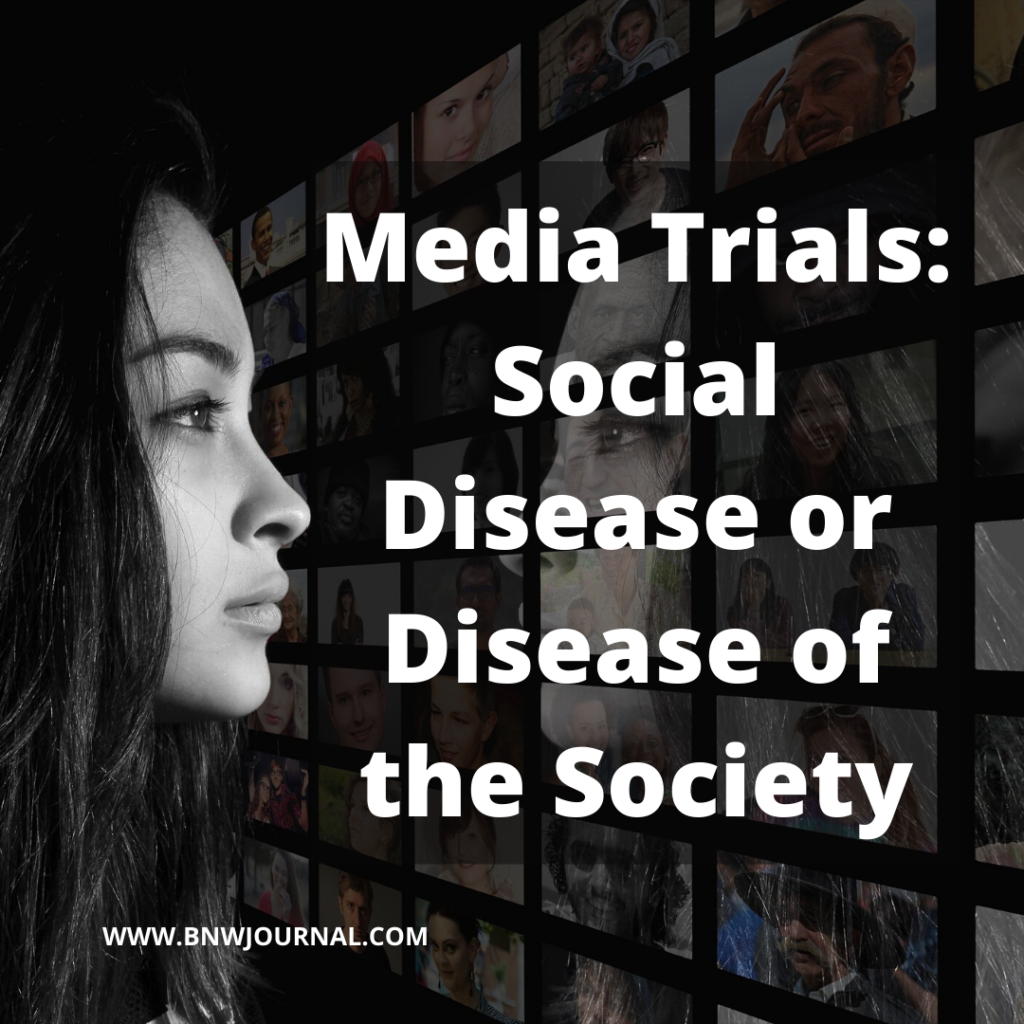![]()
Introduction
One of the pillars of democracy has been regarded as media. The role of media ranges quite widely in the social lives of people. Media plays an utmost vital role in molding the views of the people. It acquires the capability of changing the way people think in the society. It is quite commendable the way media plays an active role in bringing out the guilt of the accused. And bringing him to hook.

Media Trial is also known as trial or justice that media does. A trial done by the media violates the basic fundamental rights of individuals, i.e. right to privacy[1]. During this period of media trial it is not only the suspect or accuse who suffer. But the publicity affects the victims as well. But what about those innocents who haven’t committed the crime and still have to face media trials? This does result in mental torture which leads a person to lose his life. Due to unnecessary blames and defamation towards him.
According to article 19(1) (a) of the Constitution, media has been give the right to information. As well as the right to communicate the information. “In the case of State of Uttar Pradesh v Raj Narain[2], the Supreme Court of India has held that Article 19(1) (a), also includes the right to receive information on matters concerning public interest”[3]. However, the right to privacy is also guarantee by the constitution of India. The media shall not take advantage of the freedom of the press. It is to an extent that it will affect a person’s privacy. Media is after all platform where the news is communicated. The happenings in and around the world is communicate to the citizens of the society. But media has no right to grant justice.
Privacy has been regard as the basic human right of every individual. Article-21 also includes the right to alone. Trial by media is a phrase that covers the publications in television and newspapers. Which concerns the general public. However statute must do a fair trial, the media has no right to put any sorts of allegations against an innocent being. In this world of technology, in seconds everything gets viral through social media, which can make a person’s life as hell. Media is a platform that binds the world together and its purpose cannot be misused.
Evolution of Indian Media
For the development of the society, media is the need of the present hour. Media is consider as the fourth pillar of the democracy. It is a medium of communication of ideas across worldwide. The freedom of media is recognize by the Supreme Court under article-19(1)(a) of the Indian Constitution. Doordarshan is one of the oldest channel where news was broadcast in India. “In the case of Ministry of I & B v Cricket Association of Bengal (CAB)[4], the apex court has observed that government has no monopoly on electronic media and a citizen, under article 19(1)(a) has right to telecast and broadcast to the viewers every important event via electronic media”[5].
The only reason media was bestow with freedom was to telecast unbiased and fair news for the matter of public interest in the society. “In the case of Indian Express v Union of India, the expression ‘freedom of the press’ has not been use in Article 19 but is comprehend in article 19(1)(a). Indian press has absolute freedom from the interference with the content and circulation of the newspaper. The sole purpose behind this is to advance public opinion. Freedom of the press is the heart of social and political intercourse. It is the primary duty of the court to uphold the freedom of the press and invalidate all laws and administrative actions which interfere with it contrary to the constitution”[6].
However, the media has forgotten its purpose of existence. Telecasting fake news and bias news is against the mandate of the society. Media has no authorization or right to conduct a trial of a suspect of any crime. The principle of the criminal justice system stands as every person will be termed as innocent until proven guilty. Media is a platform for influencing public opinion which can be beneficial as well as can act as a complete loss to the society.
Media has played an active role in one of the major cases that had happened in India, to find out the guilty, widely known as the ‘Nirbhaya case’. This case was a shock for the nation-wide in turn became the focus of television, newspapers, and online media. Social media was flooding for the grant of justice to the daughter of this nation. Media and social media have become the most powerful mechanisms for mobilizing support. It was media that pressurized the authorities to deliver fair justice[7].
However, media has brutally failed to serve the purpose of its existence many times. Maharashtra has reported almost 218 fake news and hate speeches on social media since the lockdown[8]. In Khurshid Anwar’s case, Indian TV aired its investigation regarding a rape case registered in Delhi in 2013. It is telecast interview, the woman allege Khurshid Anwar has spike her drinks. And rape her at his home. However, the morning after this broadcast Anwar’s body was found and it was discovered that the interview that was telecasted by India TV pushed him over the brink[9].
The trial by any media whether electronic media, press or public agitation is very antithesis of rule of law. It can well lead to a miscarriage of justice. A judge has to guard himself against any such pressure and is to be guide strictly by rules of law. If he finds the person guilty of an offense he is then to address himself to the question of sentence to be awarded to him in accordance with provisions of law, as held in the case of State of Maharashtra v Rajendra Jawanmal Gandhi”[10].
Photographs are consider to even more intrusive than any other news report. There have been instances where the courts have restrict photographs from being publish. Stalking and then taking photographs of a person without their knowledge is a punishable offense under the provisions of IPC, 1860. Any photograph of a person who is use for commercialization shall be with the consent of the person whose photo is being use. Indian Penal Code was amended and Voyeurism was included as an offense after the Nirbhaya case[11]. “The accused is liable for voyeurism for imprisonment which can range from one to three years and in case of two conviction it can range from three to seven years. However the accused would be liable if the picture has been taken without consent in a private space or engaged in activity not usually done in public space”[12].
Impact of Sting Operation
Sting operations are conducted to catch hold of criminals. In this case, an undercover agent is involve, a detective or any co-operative member of the public plays the role of a criminal partner and helps to find out the main criminal involve in the whole act of crime. Mass media involve themselves in recording the whole act and publishing the facts.
In the year 2007, a news channel Live India conducted a sting operation in the capital city of India New Delhi, where a government school teacher was forcing a girl into prostitution. After such an expose the teacher Uma Khurana was suspend by the Education Authority. Later it was find out that the victim girl was a journalist herself. It was a cook story. Investigating Officers founds no evidence against the teacher. Hence the case was found to be false. High Court of Delhi charged the girl for creating false evidence, criminal conspiracy, and imprisonment. The Ministry of Information and Broadcasting alleged the telecast of the sting operation to be violative, defamatory containing false evidence[13].
No program or show shall be aired or telecasted which is not true or contains false allegations, defamatory statements, obscene activities, might hurt the sentiments of the social, public, and moral life of the country[14]. Channels must adhere to the rules prescribed under the Cable Television Networks (Regulation) Act, 1995.
Pre-censorship in media is not permitted. This does not mean that, media shall telecast false news to bias the general public or cause violation of the right to privacy of an individual. “False sting operation will cause an infringement to article 21 of the Indian Constitution. Recordings of a hidden camera cannot be permitted to telecast something which is not true or correct but has happened in the course of inducement. News channels shall be strictly prohibited from airing any program which will hurt the sentiments of a person or is fabricated and intrusive in nature”[15].
In another recent case, which happened in Hyderabad. A sting operation is conduct by M/s. Associated Broadcasting Company Pvt. Limited on TV9. It was based on gay culture rampant in the city Hyderabad. The News Broadcast Association declared it to be suo motu violation of the right to privacy of individuals. This was solely misused of a sting operation, as it did not depict any criminality rather it was all about the violation of sex and nudity in the code of Ethics[16]. Sting operations have seemed to be violative of right to privacy and hence it is very important that they shall create a source of public interest.
Conclusion
One of the important principles of the Criminal justice system is “fair trial”, which is also a fundamental right to every citizen. It states that no trial shall be bias or pressurize. “In Zahira Habibullah Sheikh v State of Gujarat[17], the Supreme Court has explained that a fair trial obviously would mean a trial before an impartial Judge, a fair prosecutor, and proper judicial calm”. It has been regard as an absolute right of every citizen of the country. Media being an influential platform shall exercise its powers very crucially. It makes the opinion of individuals vary.
In a recent gang-rape case held in Hyderabad, in 2019 where a medical practitioner was returning her home. And on her way she was rape and brutally kill. Soon after a few days the police officials killed four suspects. However, this is against the rule of law. According to the justice system every individual shall have a fair trial and no media or social media can pressurize punishment without trial. Justice can only be granted only when there is evidence.
Social media is a platform where people share their viewpoints by posting and reposting, but this is not a fair way to grant justice. Nobody knows the truth until and unless it is prove in the court of law. Many deaths in this country occur due to social media allegations. It is a type of defamation cause to one’s self-respect which is totally against the law. Also no one has the right to infringe a person’s privacy. The right of privacy has been enshrine under the right to life and liberty guarantee to citizens under Article 21 of the Indian Constitution. It is a right where a person has the freedom to be alone in his private space.
Every individual in this country has the freedom to safeguard his privacy, his family, marriage, motherhood, education, relationships, etc among all other matters in his day to day life. Anything which concerns the private life of the person cannot be published without his prior consent, it does not matter whether the statement is true or a critic. Any matter which has been published about a person’s private life in violation of article 21 and amounts punishment.
However the above-mention rule is subject to the exception. If any publication is made concerning the private life of a person and such a publication if it is base upon public records and court records. Then it cannot be objected. When any matter which comes under the purview of public records, it can be accessible by the general public then it no longer subsists the right to privacy, rather it becomes a legitimate subject for the press and media. However there is another exception to this rule that when there a female victim in any case of sexual assault, kidnap, abduction, or any such offense then there shall be no publication regarding such victims, it will be regarded as a violation against their dignity.
Media is a pillar of democracy shall not interfere within the functioning of the justice system and shall allow fair justice to be delivered.
References:
[1] Article-21
[2] 1975 AIR 865
[3] Ibid no. 2
[4] 1992 2 SCC 161
[5] Ibid no. 4
[6] (1985) 1 SCC 641
[7] Rishi Gautam, The-delhi-gang-rape-the-role-of-media-in-justice-by-rishikesh-kumar-gautam-sonalee-nargunde, https://www.academia.edu/8365034/The-delhi-gang-rape-the-role-of-media-in-justice-by-rishikesh-kumar-gautam-sonalee-nargunde (last visited May 10, 2020).
[8] Maharashtra: 218 cases of fake news and hate speeches on social media since lockdown | Mumbai News – Times of India, , https://timesofindia.indiatimes.com/city/mumbai/maharashtra-218-cases-of-fake-news-and-hate-speeches-on-social-media-since-lockdown/articleshow/75185373.cms (last visited May 10, 2020).
[9] Khurshid Anwar suicide case: Victim stresses on rape charge – India News, , https://www.indiatoday.in/india/north/story/ngo-boss-khurshid-anwar-suicide-case-police-records-victim-statement-sexual-assault-charges-221806-2013-12-24 (last visited May 10, 2020).
[10] 1997 (8) SCC 386
[11] Mukesh & Anr v State for NCT of Delhi & Ors.(2017) 6 SCC 1
[12] Section 354C of IPC, 1860
[13] Jagran T.V. Pvt Ltd v Union Of India, WP(Crl.)No. 1175/2007
[14] Section-5 of the Cable Television Networks (Regulation) Act, 1995
[15] Ibid no. 10
[16] News Broadcasters Association – NBA New Delhi, , http://www.nbanewdelhi.com/ (last visited Feb 28, 2020).
[17] 2005 (2) SCC (Jour) 75



0 Comments